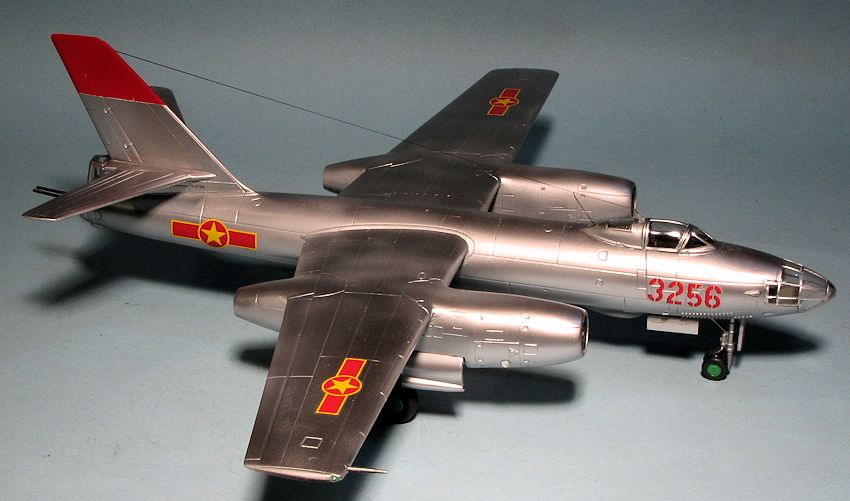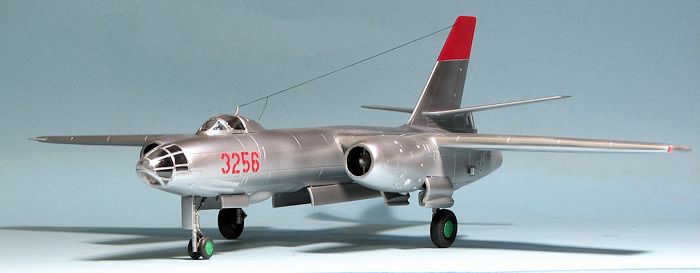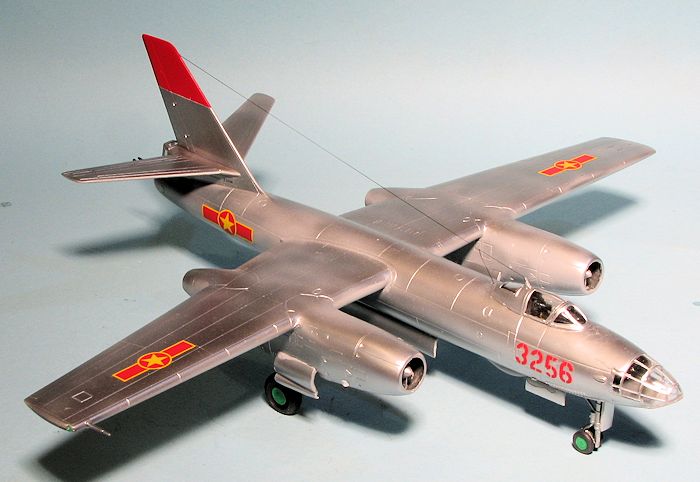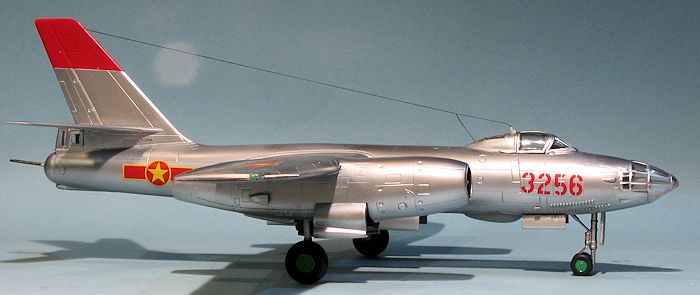
Trumpeter 1/72 IL-28 'Beagle'
| KIT #: | 01604 |
| PRICE: | $3.00 'Used' |
| DECALS: | One option |
| REVIEWER: | Scott Van Aken |
| NOTES: | Started |

| HISTORY |
The Ilyushin Il-28 (Russian: Илью́шин Ил-28 NATO reporting name: Beagle) is a jet bomber aircraft of the immediate postwar period that was originally ma nufactured for the Soviet Air Force. It was the USSR's first such aircraft to enter large-scale production. It was also licence-built in China as the Harbin H-5. Total production in the USSR was 6,316 aircraft, and over 319 H-5s were built. Only 187 examples of the HJ-5 training variant were manufactured. In the 1990s hundreds remained in service with various air forces over 50 years after the Il-28 first appeared. The only H-5s in service are approximately 30 aircraft which operate with the Korean People's Air Force.
nufactured for the Soviet Air Force. It was the USSR's first such aircraft to enter large-scale production. It was also licence-built in China as the Harbin H-5. Total production in the USSR was 6,316 aircraft, and over 319 H-5s were built. Only 187 examples of the HJ-5 training variant were manufactured. In the 1990s hundreds remained in service with various air forces over 50 years after the Il-28 first appeared. The only H-5s in service are approximately 30 aircraft which operate with the Korean People's Air Force.
| THE KIT |
The turn of the century was when we first started hearing about Trumpeter kits and so I'm thinking this one must be one of their earliest products. This kit was bought with the wings glued together so qualified as 'used' at the LHS. Still, it is complete and so a preview seemed in order.
and so a preview seemed in order.
Molding is quite good with engraved panel lines that are probably more pronounced than one would see in other kits of the time, but not really all that bad. Prior to this kit, we had the quite old Airfix version and much later, Bilek kitted the aircraft. This latter kit has been seen in a number of other boxes, including Italeri.
The kit offers a usable cockpit and bombardier's section, complete with (as appropriate) seats, control sticks, consoles and a bombardier's seat in the very nose. Instrument panel detail is raised. Two four piece seats are provided with belt detail molded in place. Two crew members are also provided.
The builder is provided with a full bomb bay and an option for one large bomb in the middle and either two or four smaller ones on the outer walls. All look very much like German WWII bombs. A tail turret is also provided and is nothing really to write home about, though it does offer a crew entry hatch that can be displayed open if one wishes. On the engine nacelles there is an engine face to fit along with a splitter that is trapped between two forward engine housings. On the back there is just a cap with no tail pipe. A wheel well fits into the two nacelle halves. I should mention that there is no nose gear well with the nose strut simply gluing to the bottom of the bombardier's station. Landing gear are adequate though seem rather simplified. Gear doors are separate after one cuts them apart. Main wheels are two pieces with nose wheels a single molding. Detail is somewhat generic on the wheels. Tip tanks are provided for the wings should you wish to use them.
On the engine nacelles there is an engine face to fit along with a splitter that is trapped between two forward engine housings. On the back there is just a cap with no tail pipe. A wheel well fits into the two nacelle halves. I should mention that there is no nose gear well with the nose strut simply gluing to the bottom of the bombardier's station. Landing gear are adequate though seem rather simplified. Gear doors are separate after one cuts them apart. Main wheels are two pieces with nose wheels a single molding. Detail is somewhat generic on the wheels. Tip tanks are provided for the wings should you wish to use them.
Instructions are nicely drawn and use Tamiya paint references. The lone markings option is for a Chinese version in olive drab over a mixture of light blue and grey. Decals in my kit have a rippled surface to them and since the backing paper is white, it is difficult to make out the white numbers, much less photograph them. Fortunately, there are aftermarket decals that one can use. I should point out that the marking option plane does not use the tip tanks.
| CONSTRUCTION |
As mentioned earlier, this kit was bought started. The previous builder had cemented the wings together and had built the fuselage in that the interiors and bomb bays were done, the tail cone added and the halves were cemented together. This was not done well and some parts had to be pried apart to reglue. I then did the filler thing to all the joins that needed it and this kept me occupied for a while. I should add t hat the upper forward fuselage hatch was missing so I had to make one out of plastic card.
hat the upper forward fuselage hatch was missing so I had to make one out of plastic card.
Once I got what had already been done cleaned up and filled, I started adding new stuff. This part began by painting the inside of the engine cowlings, the splitter section and the forward nacelles that had the forward engine parts molded onto it with silver. Don't bother detailing any of the inner stuff as, unless you jam a flashlight in there, you won't see anything. The splitter sections do not fit all that well as their outer curve shape is sharper than the inside of the forward cowling bits. Once those were glued together and fairly solid, I glued them on to the nacelle fronts. The cowlings tend to be taller than the nacelle fronts, so one has to do some judicious squeezing and super glue application to get them the right shape. Even then the fit is not good so more filler and sanding.
Eventually, I got the wings pretty well done. I then painted and glued in the seats and the control stick. The one for the bombardier was not easy to get into the already assembled fuselage. Meanwhile, I glued the wheels together and then started to glue on the main wings, doing these one at a time. Once they were on, I filled the seams to the fuselage. I also decided to try to fit in the rear transparency before the tailplanes would get in the way. A bit of background. The kit comes with one tai section molded in place and tells you to cut that off and install another. Trouble is that the 'another' doesn't fit the transparency. Other than needing to shave off most of the upper fuselage aft of the rudder, when the transparency is fitted, there are gaps along the aft side of it. Had the original tail been left on, the transparency would have fit with no issues.
I then masked the transparency and built the tail turret. The back of the turret looks nothing like what is in the instructions, but isn't difficult to figure how it fits. Not surprisingly, it is smaller in diameter than the  surrounding fuselage. There is another tail turret assembly on the 'A' sprue that fits perfectly into the original tail section. However it is a different design so check references to see which is appropriate for your markings option. I had the suspicion that the alternate version is one used on Chinese built planes, but checking photos it seems the other way around. The molded on tail is for the Harbin H-5 while the other version seems to be for Soviet built planes.
surrounding fuselage. There is another tail turret assembly on the 'A' sprue that fits perfectly into the original tail section. However it is a different design so check references to see which is appropriate for your markings option. I had the suspicion that the alternate version is one used on Chinese built planes, but checking photos it seems the other way around. The molded on tail is for the Harbin H-5 while the other version seems to be for Soviet built planes.
With that in place, the built moved to the transparencies. I masked and fitted the tail transparency then headed for the nose. Masking the nose transparent was a bit of a chore due to all the curved panels but got it done and glued it on. The section on the right side is too small for the opening, so I used clear paint to fill in the gaps. The three piece main canopy fit fairly well. I would have preferred it to be a single piece or at least have that as an option, but this is an old (1998) Trumpeter kit and I guess they felt the ability to have the canopy open was a plus. The clear plastic is quite thick.
I also took this opportunity to add the pitot, radio mast, horizontal stabs, and a few small T antennas to the underside of the wing Then I stuffed all the openings with tissue in preparation for painting.
| COLORS & MARKINGS |
Using the kit decals was a thought, but I figured they'd be terrible so ordered a sheet of IL-28s that had some interesting options. This sheet was ordered from Canada several weeks ago and had not yet arrived so I decided to start off by priming the kit, which I did using Tamiya extra fine grey primer. I then sprayed the airframe and outer gear doors with Alclad II Aluminum. Since I was doing a North Vietnamese plane, the fin was painted white and later painted red. Naturally, it doesn't match the red on the decals....
| FINAL CONSTRUCTION |
With the airframe painted, I painted the landing gear dark aluminum and glued those in place. I then did a bit of touchup on the aluminum where I'd goofed up. I then removed all the tissue and glued on the gear doors. I used both Tamiya cement and super glue for these. The attachment stubs are really quite long and those doing contest work will want to cut those off. Then the wheels were glued on. For the bomb, I wasn't sure what color to paint it so I went with a light grey, the shade of current Russian bombs. This was c emented into the bomb bay and the bay doors were glued on.
emented into the bomb bay and the bay doors were glued on.
Then it was time for decals. I chose HiDecal 72-043 for this one. Not much out there for this plane in this scale. There are two full bomber options on this one and I went with the North Vietnamese version. These were used against Laos in the early 1970s so they didn't just sit on the tarmac. I have to say that am quite pleased with these decals. They are thin, but tough enough to take some handling. They also seemed to be quite opaque.
Naturally, I knocked off several of the gear doors and bomb bay doors during all the handling for the decals, some more than a few times! The only other bits to add were the clear landing light bubbles and the wing tip light lenses. The wing tip lights were about twice the size they needed to be so instead, I used clear paint to fill the void. This took a couple of applications, but looks a whole lot better. The final thing to do was to attach the long wire using EZ Line and remove the masking.
| CONCLUSIONS |
 I am not sure how many of you are seriously considering building this kit, but it really isn't all that bad. One just has to keep a few things in mind. One is to be careful in regards to the tail section. Check photos of the version you want to build and if it is a Harbin-built plane, don't cut off the kit tail. Second is to prepare to use those modeling skills for filler and adjusting parts to fit. One would hope that Hornby would add the IL-28 to its list of kits from the old catalogue to re-do, but I wouldn't hold my breath. While probably not an award winner, the Trumpeter kit can be built and does make into a nice model for your shelves.
I am not sure how many of you are seriously considering building this kit, but it really isn't all that bad. One just has to keep a few things in mind. One is to be careful in regards to the tail section. Check photos of the version you want to build and if it is a Harbin-built plane, don't cut off the kit tail. Second is to prepare to use those modeling skills for filler and adjusting parts to fit. One would hope that Hornby would add the IL-28 to its list of kits from the old catalogue to re-do, but I wouldn't hold my breath. While probably not an award winner, the Trumpeter kit can be built and does make into a nice model for your shelves.
| REFERENCES |
July 2014
Thanks to me for picking this one up.
If you would like your product reviewed fairly and fairly quickly, please contactthe editor or see other details in the